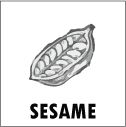
Afflicts 0.5% but is SEVERE and DEADLY
- More than 300,000 people in the United States suffer from sesame allergy, which is ranked 9th in prevalence among the most commonly diagnosed food allergies.
- 17% of children with other food allergies are also allergic to sesame.
- 39% of children and 45% of adults had severe reactions, defined as a reaction involving at least two organ systems or anaphylaxis.
- Allergic reactions to sesame also tend to be some of the most severe.
Relevance to Food Service
- Sesame is an easily-hidden ingredient in many fresh foods, such as Tahini in Hummus.
- Sesame oil is far more allergenic than its seed.
- Tiny amounts can cause a severe reaction.
- Sesame oil is a common ingredient used to prepare sauces.
- Sesame is often present in “Whole Grain” breads and rolls; It is present in many “Gluten-Free” packaged goods such as energy bars, breads, crumb coatings, cookies, etc.
- Clean all surfaces thoroughly with warm soapy water.
FARE responds to Sesame being added to products that do not already contain it to ease allergen control at the point of manufacture, limiting sesame-free products in the marktplace.
https://www.foodallergy.org/resources/companies-not-adding-sesame-flour-products
Dietary Labeling for Sesame
Even tiny amounts of sesame protein can trigger a reaction.
Adverse effects have been documented from as little as 1 mg of sesame protein – the amount found in just two sesame seeds.
Benne
Gomashio
Halvah
Sesame Seed
Sesame Oil
Simsim
Tahini
AVOID
Sesame seeds
Sesame oil
Sesame flour
Sesame paste
Sesame derivatives – may contain allergy-triggering sesame proteins and can appear in unexpected places, such as:
- Tomato sauce
- Beef jerky
- Candy
May contain Sesame
Ready-to-eat cereal
Breakfast/cereal/snack bars
Hot cereal/oatmeal
Pretzels
Tortilla/tostada chips
Hard candy/package and roll candy
Non-chocolate chew candy
Condensed wet soup
Dry soup
Granola bars
Frozen pizza
Refrigerated bacon
All other crackers
Chocolate candy snack size
Chocolate candy box/bag/bar (all sizes)
Spice/seasoning
Cookies
Cheese snacks
Multi-serve frozen dinners/entrees
Single-serve frozen dinners/entrees
Frozen handheld entrees
Sesamum indicum
Commonly known as sesame, is a plant species in the family Pedaliaceae. Sesame is widely cultivated for its seeds, which are used in various culinary and non-culinary applications. The seeds are rich in oil and protein and have a nutty flavor. They are used in a variety of dishes, including baked goods, sauces, and salads, and are also used to produce sesame oil.
However, sesame is one of the most common food allergens, and individuals with sesame allergy need to avoid products that contain sesame or that may have come into contact with sesame.
Sesame as Allergen
The scientific designation for sesame allergens is Ses i 1, Ses i 2, and Ses i 3. These are proteins that are commonly responsible for sesame seed allergies. Sesame allergies are growing in frequency, and it is important for people with this allergy to be able to identify products that contain sesame, as it is often used in processed foods and can be found in unexpected places.
Why is there sesame in tomato products?
Sesame is sometimes used as an ingredient in tomato-based products, such as tomato sauces and ketchup, because it can provide a nutty flavor and a rich, creamy texture. Sesame oil is a popular ingredient in many cuisines and is known for its unique flavor profile and health benefits.
In addition to its flavor, sesame can also serve as a natural emulsifier, helping to stabilize the sauce and prevent separation. Some tomato-based products, such as barbecue sauces and marinades, may also contain sesame for its ability to help the sauce adhere to food and improve the overall flavor and texture.
Which products carry small amounts of sesame?
Sesame is a common food allergen, and it can be found in a variety of products, including some that may contain only small amounts of sesame. Here are some examples of products that may carry small amounts of sesame:
Baked goods: Some breads, crackers, and pastries may contain sesame seeds or sesame oil as an ingredient or as a topping.
Spices and seasonings: Sesame seeds and sesame oil are sometimes used as ingredients in spice blends, such as spice rubs, and in some Asian-style sauces and marinades.
Snack foods: Sesame seeds are a common ingredient in some snack foods, such as crackers and granola bars.
Dips and spreads: Hummus, tahini (a paste made from ground sesame seeds), and some nut butters may contain sesame.
Sauces and condiments: Some sauces, such as teriyaki sauce and Worcestershire sauce, and condiments, such as mayonnaise, may contain small amounts of sesame oil.
It is important for individuals with a sesame allergy to be aware of these products and to always check ingredient labels when shopping and eating out. Even small amounts of sesame can cause a severe reaction in some individuals, and cross-contamination may occur during the manufacturing or cooking process.